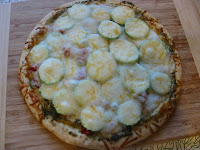

The last few deliveries have included a large bunch of rapini. This is another case where the box has introduced me to a new ingredient that I need to figure out how to cook.
Rapini is also called broccoli raab (or broccoli rabe). According to Wikipedia,
Rapini is classified scientifically as Brassica rapa subspecies rapa,in the same subspecies as the turnip.Rapini has many spiked leaves that surround a green bud which looks very similar to a small head of broccoli. There may be small yellow flowers blooming from the buds, which are edible.
The flavor of rapini has been described as nutty, bitter, pungent, and "an acquired taste." The Italian cultivar is similar to, but much more bitter than the Chinese. The Chinese cultivar is of a lighter green color, not at all bitter or pungent, and more tender.
Rapini is a source of vitamins A, C, and K, as well as potassium, calcium, and iron.
Rapini is grown in California from August through March making it a great candidate for the fall garden. The informational insert that came with this week's box has you blanching the rapini for a few minutes in salted boiling water. Many of the recipes I found online confirmed this approach.
To blanch the rapini: Bring 3 quarts of water to a boil, Meanwhile, clean and cut the rapini leaves into 1 inch strips. When water begins to boil, add 2 teaspoons of salt and the greens. Stir until wilted and tender (1-2 minutes). Drain pot into colander. Fill the pot with cold water and submerge greens to stop cooking. Dry in a salad spinner.
So last night's dinner featured the blanched rapini and a roasted butternut squash (both from the box) going into a risotto. A few drops of truffle oil after plating made for a great meal on a cloudy, rainy day.
The blanched rapini is one approach but you can also explore some other strategies. Two recipes (one from Rachael Ray and another from Mariquita Farms) have you wilting the rapini in a skillet with broth or water along with the other ingredients. This local food blog makes a great case for roasting it which I look forward to trying.









































